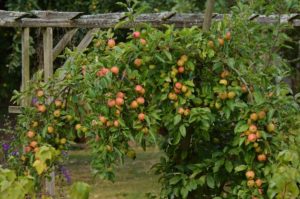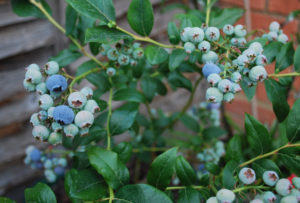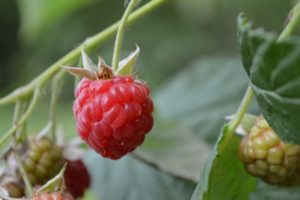-Luis Guerra-

Ahhhh! There’s nothing like eating a fresh-picked piece of fruit or a handful of berries, warmed by the sun and perfectly ripe. Especially if it’s in the comfort of your own yard.
The nice cool temperatures of spring offer the perfect opportunity to get started planting some edible perennials on your property so you can enjoy the delicious bounty these plants offer.
A number of fruit-bearing plants grow very well in our area in small spaces and with little effort, while other varieties require a bit more planning or attention. Apples, pears and cherries are three easy-to-grow trees if you have a larger-sized lot. Even the semi-dwarf varieties will need twenty feet of width and height to accommodate their eventual size. By using a practice called ‘Select Pruning’ or ‘Espaliering’, however, you can train these trees to stay smaller and still produce a huge bounty – although these practices require a good bit of time and attention.
Please note: some fruit trees are self-pollinating, while some require another plant of the same species within a certain area to pollinate properly. When selecting your plant remember to check the pollination requirements, so you know whether you need to have multiple trees to achieve fruiting.

Other edibles that do not require so much room are fig trees and berry bushes. Blackberries, raspberries, blueberries, strawberries, and figs all grow well in our region. (Be aware that some fig trees may not be cold-hardy for our area, but every tree we sell at Fifth Season is appropriately cold-hardy and was raised nearby so is already acclimated to our conditions.) Fig trees and berry bushes require very little maintenance to get a nice harvest – a bit of pruning in the winter and some fertilization in the spring, and you’re generally good to go.
The key to a successful orchard is placement. Fruit trees require lots of sunshine (6 hours or more) and prefer a sloped area to produce fruit. Strawberries, too, like a nice sunny spot. Cane fruit, on the other hand, can be planted in shadier, low lying areas around your yard and yield fruit, and blueberry bushes, while liking sun, can also tolerate some shade, particularly in the afternoon.
Edibles also require some soil amending when initially planted, and require weeding through the growing season. Compost, rock phosphate and kelp should be mixed with some native soil; the planting hole should measure three times the size of the container your plant came in. Plant your selections slightly above the ground level, to help with drainage and compensate for some settling. Surround the area around the trunk with cardboard (sheet mulching) and top off with wood chips or mulch. Make sure not to bury any of the trunk above root zone to prevent any rot issues from occurring.

Berry bushes require specialized fertilizing that will lower the pH of the soil, as berries like acidic conditions, blueberries particularly so. Think about wild huckleberries and blackberries growing at the edge of the woods with the nice pine-needle mulch they get every year, and this will make sense. For a more extensive tutorial on berry planting and cultivation, check out Pam’s blog post on berry gardening.
Water your plants frequently and deeply after the initial planting to help them get established. In subsequent years, watering may be necessary only during dry spells. You may want to consider using bird/deer netting to protect your harvest from critters if your plants aren’t fenced.

Leave a Reply